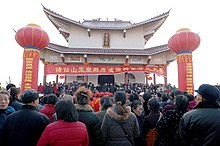Chinese kin
| Chinese kin | |||||||||||||||
|---|---|---|---|---|---|---|---|---|---|---|---|---|---|---|---|
| Chinese | Tông tộc | ||||||||||||||
| |||||||||||||||
| Alternative Chinese name | |||||||||||||||
| Chinese | Gia tộc | ||||||||||||||
| |||||||||||||||
AChinese kin,lineageor sometimes rendered asclan,is a patrilineal and patrilocal group of relatedChinesepeople with a commonsurnamesharing a common ancestor and, in many cases, anancestral home.
Description
[edit]Chinese kinship tend to be strong in southern China, reinforced by ties to an ancestral village, common property, and often a common spokenChinese dialectunintelligible to people outside the village. Kinship structures tend to be weaker in northern China, withclanmembers that do not usually reside in the same village nor share property.
Zupu—the genealogy book
[edit]Azupu(simplified Chinese:Gia phả;traditional Chinese:Gia phả;pinyin:zúpǔ;Pe̍h-ōe-jī:Cho̍k-phó͘) is a Chinese kin register orgenealogy book,which contains stories of the kin's origins, male lineage and illustrious members. The register is usually updated regularly by the eldest person in the extended family, who hands on this responsibility to the next generation. The "updating" of one'szupu(simplified Chinese:Tu gia phả;traditional Chinese:Tu gia phả;pinyin:xiū zúpǔ;Pe̍h-ōe-jī:Siu cho̍k-phó͘) is a very important task in Chinese tradition, and can be traced back thousands of years. After several generations, the local clan lineage will often publish a compendium of these zupus. The overwhelming majority of zupus remain in private hands, though a large number may be found in thePeking University,Shanghai Library,Cornell UniversityandTōyō Bunko.
Chinese lineage associations
[edit]

Chinese lineage associations,alsokinshiporancestral associations(simplified Chinese:Tông tộc xã hội;traditional Chinese:Tông tộc xã hội;pinyin:zōngzú shèhuì;Pe̍h-ōe-jī:Chong-cho̍k Siā-hōeorsimplified Chinese:Tông tộc hiệp hội;traditional Chinese:Tông tộc hiệp hội;pinyin:zōngzú xiéhuì;Pe̍h-ōe-jī:Chong-cho̍k Hia̍p-hōe), are a type ofsocialrelationship institutions found inHan Chineseethnic groups and the fundamental unit ofChinese ancestral religion.They gather people who share the samesurnamebelonging to the same kin, who often have the same geographical origin (ancestral home), and therefore the same patrondeities.They are not seen as distinct from the Chinese kin itself, but rather as its corporate form. These institutions and their corporeal manifestations are also known aslineage churchesorkinship churches(Chinese:Tông tộc đường;Pe̍h-ōe-jī:Chong-cho̍k-tông;pinyin:zōngzú táng), or, mostly on the scholarly level, asConfucian churches,[1]although this term has principally other different meanings.
Chinese kinship associations are the corporate forms of kins and the fundamental unit ofChinese ancestral religion.They provideguanxi(social network) to members and they build and manageancestral shrinesor temples dedicated to the worship of theprogenitorsof the kins as their congregational centers, where they performritesof unity.[2]
A lineage is acorporation,in the sense that members feel to belong to the same body, are highly conscious of their group identity, and derive benefits from jointly owned property and shared resources.[3]Benefit derives from the surplus income of ancestral shrines and homes, which is reinvested by the managers or shared out in yearly dividends.[4]Benefit of belonging to a lineage can also be measured in terms of protection and patronage.[4]Ancestral temples also support local schools and engage incharitable work.[5]
Different lineages may develop through the opposite processes of fusion and segmentation.[6]They can also be dispersed and fragmented into "multi-lineage areas" or concentrated in one place, or "single-lineage area".[6]
Ancestral shrine
[edit]
Ancestral temples or shrines are the congregation places of lineage associations, by whom they are built and managed. These temples are devoted to the worship of theprogenitorsof a certain kin, where the kin members meet and performritesof unity and banquets.[2]
Variations
[edit]Consort kinship
[edit]In Imperial times, aconsort kinwas a kin with special status due to its connection with an emperor. Throughout Chinese history, consort kins have exercised great power at various times. There have been several usurpations of power by consorts, the most notable being theHan dynasty'sEmpress Dowager Lü(Chinese:Lữ hậu;pinyin:Lǚ hòu), theTang dynasty'sEmpress Wu(simplified Chinese:Võ Tắc Thiên;traditional Chinese:Võ Tắc Thiên;pinyin:Wǔ Zétiān;Pe̍h-ōe-jī:Bú Chek-thian), and theQing dynasty'sEmpress Dowager Cixi(Chinese:Từ Hi thái hậu;pinyin:Cíxǐ tàihòu). The Han dynasty usurperWang Mangwas a nephew of theGrand Empress Dowager Wang.[citation needed]
Qing period
[edit]During theQing dynasty,the imperial government encouraged Chinese kins to take up some quasi-governmental functions such as those involving social welfare and primary education.[citation needed]
See also
[edit]- Chinese folk religion
- Confucianism
- Chinese ancestral worship
- Ancestral shrine&Ancestor tablets
- Chinese surname—Hundred Family Surnames
- Chinese lineage associations
- Ancestral home
- Guanxi
- Kongsi
- Xungen movement,the contemporary reconstruction of lineages inChina
- Zupu
- Ethnic interest group
References
[edit]Citations
[edit]Sources
[edit]- Watson, James L. (December 1982). "Chinese Kinship Reconsidered: Anthropological Perspectives on Historical Research".China Quarterly.92(92): 589–622.doi:10.1017/S0305741000000965.JSTOR653680.S2CID145418707.
- Tsai, Lily Lee (July 2002). "Cadres, Temple and Lineage Institutions, and Government in Rural China".The China Journal(48): 1–27.doi:10.2307/3182439.JSTOR3182439.S2CID147239659.
- Cohen, Myron L. (August 1990). "Lineage Organization in North China".The Journal of Asian Studies.49(3): 509–534.doi:10.2307/2057769.JSTOR2057769.S2CID163489363.
